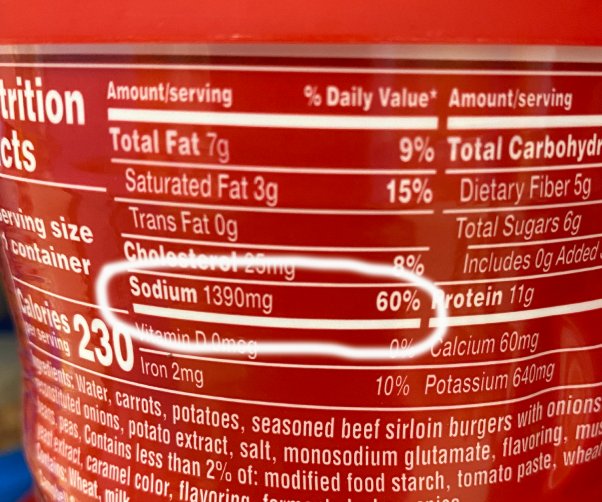
High-Sodium Foods to Steer Clear of This Winter (and All Year Round)
If you’re trying to eat healthier in the new year, you’re not alone. Whether you’re hoping to lose weight, improve your heart health, or just feel better, making dietary changes for the better in January is one of the most popular New Year’s resolutions.
“One of the easiest changes you can make is to limit the high-sodium foods you eat,” says Jeff Mullins, M.D., primary care provider with Methodist Le Bonheur Healthcare. “Many common foods are packed with high levels of sodium — and not just the junk food you might think.”
Why You Should Cut Back on Sodium
Your body needs sodium, or salt, to function. You probably know this — after all, your sweat and tears are salty, right? Salt helps to keep the fluids in your body in balance. But consuming too much over a long period of time can negatively affect your heart and cause other problems. High amounts of sodium in your diet can lead to high blood pressure.
Also called hypertension, high blood pressure can cause many other problems, such as:
- Heart attack
- Heart disease
- Kidney disease
- Sexual dysfunction
- Stroke
- Vision problems
High daily sodium intake is linked to other health problems, including osteoporosis. During pregnancy, there is a link between high-sodium diets and complications such as pregnancy-induced hypertension. Hypertension during pregnancy can cause health issues for both the mother and the baby.
How Much Sodium Do You Need?
Statistics show that 90% of Americans consume more sodium than they should. The recommended amount of sodium per day varies by your age:
- Age 1 to 3: 1,200 milligrams (mg) or less
- Age 4 to 8: 1,500 mg or less
- Age 9 to 13: 1,800 mg or less
- Age 14 and up: 2,300 mg or less
If you have certain health conditions, your primary care provider or cardiologist may have already recommended a lower daily sodium intake. Diet-tracking apps and food journals can help you keep up with how much you consume.
Watch Out for High-Sodium Foods
While you can cut down your sodium content by limiting the amount of salt you cook with or sprinkle on food at the dinner table, most of the sodium you eat isn’t coming from table salt. Sodium is a common preservative in many processed foods, and even foods that do not taste salty can have high levels of sodium.
According to the Centers for Disease Control and Prevention, these ten types of foods account for more than 40% of most Americans’ daily sodium intake:
- Breads and rolls
- Burritos and tacos
- Cheese, especially processed cheeses and harder, aged cheeses
- Chicken
- Cold cuts and cured meats
- Eggs and omelets
- Pizza
- Sandwiches
- Savory snacks, such as crackers and chips
- Soups, especially canned soup
Some of these foods on their own, such as eggs and chicken, do not have particularly high sodium levels. But if you get scrambled eggs or fried chicken at a restaurant, typically, a lot of salt will have been added. Cooking fresh meats at home can lower your sodium intake significantly.
Other foods that are high in sodium include condiments and preserved products, such as:
- Barbecue sauce
- Ketchup
- Olives
- Pickles
- Salad dressings
- Soy sauce
In general, processed foods are likely to have higher sodium levels than fresh foods. Canned vegetables often have far higher sodium levels than frozen or fresh vegetables. Rinsing your canned foods before eating can help cut down on excess sodium.
Sodium in Your Glass
Sodium can show up in many places you wouldn’t expect it, including drinks. If you’re trying to cut back your sodium intake, make sure to read nutrition labels on what you drink as well as what you eat.
Some of the biggest offenders include:
- Chocolate milk drinks, including those made with nut milk
- Energy drinks
- Flavored instant coffee mixes
- Hot cocoa mix
- Milkshakes
- Mixed fruit juices
- Instant tea
- Sports drinks
While alcohol on its own generally has low sodium content, many mixers may have added sodium. Additionally, alcohol consumption can lead to high blood pressure, so drink in moderation, if at all.
SUBSCRIBE TO OUR BLOG
and you'll receive more health & wellness tips right in your inbox.
SUBSCRIBE NOWTips for Adopting a Lower-Sodium Diet
Whether you’re used to cooking most of your meals at home or you dine out daily, you can do several things to lower your sodium intake.
Choose Fresh Foods
Buy a chicken and roast it yourself instead of buying a rotisserie chicken. Doing so can cut the sodium levels by 75% or more. If you’re dining out, choose salads with the dressing on the side, steamed vegetables, and grilled or roasted meats without extra sauces.
Read The Labels
Any processed foods in the grocery store should have nutrition labels that list sodium content. Aim for products with sodium levels at 5% or lower of your daily value. If you’re buying frozen meals, opt for those containing less than 600 mg of sodium per serving (the U.S. Food and Drug Administration limit for an entree to be labeled “healthy”).
Research Your Options
If you’re eating out, visit the restaurant’s website. Many chain restaurants provide nutrition information online, even if it’s not on the menu. Searching the internet can also help you find sodium levels of similar dishes that may help you make smart choices.
Shop for “No Salt Added,” “Reduced Sodium” or “Reduced Salt” Items
Many of your favorite canned soups, salad dressings and snacks have lower sodium options. Remember to check the label and opt for foods containing less than 600 mg of sodium per serving.
Spice it Up
Spices and herbs have little or no sodium and pack a flavorful punch to whatever you make. Just be sure to read the labels, as some spice blends may include salt.
Making Heart-Healthy Changes Takes Time
Just like making any changes in your life, switching to a lower-sodium diet takes some getting used to. Try to embrace the challenge and encourage other family members to help.
While studies have proven the link between high sodium diet and diseases like hypertension and heart disease, like any lifestyle change, talk to your provider about changes you’re trying to make in the new year - especially if you have significant medical problems, are elderly, or regularly take medications of any type.
Fortunately, your Methodist Le Bonheur Healthcare primary care provider has plenty of advice. We’re here to cheer you on every step of the way.
Need more heart-healthy eating tips? Your Methodist Le Bonheur primary care provider can help.
Related Articles


